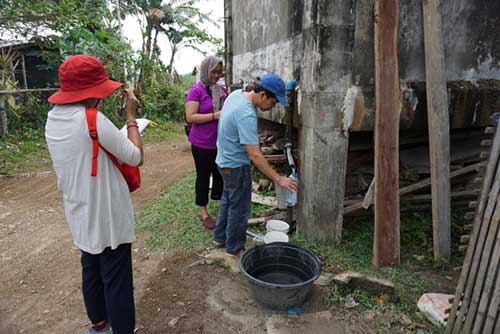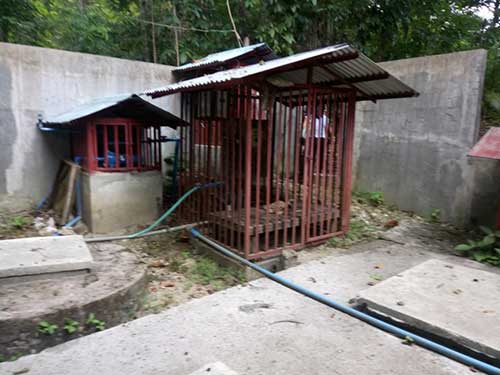
By Rosalie Arcala Hall
(The author is a professor and program manager of the UP Visayas and CHED Project “Where Water Flows.” She can be reached via rbarcalahall@up.edu.ph)
Access to safe and adequate water for household use is a continuing challenge in many Philippine communities.
Although the Philippines has seen steady improvements in UN Sustainable Development Goal 6 (providing water and sanitation for all) with access to basic improved water sources reaching 94% in 2017, there are hidden inequities within these figures (United Nations Children’s Fund and World Health Organization, 2019).
While 38% of urban households have water piped into their dwelling or yard (Level III), only 22% of rural households do (World Bank Group Water and Sanitation Program, 2015).

Moreover, 69% of richest quantile have access to Level III water systems versus 4% of poorest quantile (World Bank Group Water and Sanitation Program, 2015). For many poor rural households, like those on Guimaras, domestic water shortage is a stark reality.
Institutional arrangements underpin access to domestic water. As all water belongs to the national government, permits are issued by the National Water Resources Board (NWRB) granting rights for extraction and distribution.
There is a variety of domestic water service providers (WSP) – water districts, municipal LGUs waterworks, barangay LGU and community-based organizations (CBOs) called Barangay Waterworks and Sanitation Association (BAWASA) and Rural Waterworks and Sanitation Association (RWSA).
Unlike water districts which service cities and town centers, community-based organizations (CBOs) and LGUs operators are weakly regulated. Many of them have no water permits and have wide disparities in the tariffs they collect as well as levels of managerial competence.
The Listahang Tubig, the national water registry, has incomplete data on CBOs and LGU operators. Of households with access to formal water service providers, almost 20% of Level III access, and 35% of Levels I (protected well or spring, tube wells and boreholes without distribution system) and II (communal or public faucets) access are from CBOs and LGU operators (De Veyra and Hall, 2018).
National government initiatives, like DILG’s Salintubig, Bottom-up Budgeting and the DSWD Kalahi CIDSS, fund domestic water projects through LGUs and these CBOs.
To understand these institutional dynamics, UP Visayas, with funding from CHED, conducted a study of 15 upland, midland and coastal barangays in Guimaras province with Level II or III water systems.[1] Owing to the island’s mainly limestone geomorphology, Guimaras has limited and unevenly distributed water catchments across the municipalities.

San Lorenzo and Sibunag have fewer water sources, while the water districts in Buenavista, Nueva Valencia and Jordan rely on very old spring sources. The spring sources are situated inside private properties, necessitating some formal contracting for the lot owner to allow access, as in the case of Morobuan LGU and Sitio Bulan-Bulan (Sta. Teresa, Jordan).
WSPs only partially cover barangay or sitio households, with the smallest proportion in Igcawayan and Suclaran. Scattered households and topography delimit gravity-based pipeline distribution.
Three (out of 4) barangay LGU WSPs and one (out of 2) BAWASA have no water permit. Expansion of coverage is highly contingent on proximity to available source, hence Jordan’s water district is able to extend water service to two barangays in Sibunag close to the Bulwangan river but not to barangays farther out.
Based on two sampling cycles, the physico-chemical properties of water at consumption points are within acceptable national standards. However, above-standard coliform presence indicates external contamination at distribution points or at storage (Lozada et al, 2020).
From the survey, a majority of respondents have combined water sources, with spring, protected well or tankered water as alternatives to their main WSP. They also differentiate between uses of water, with water from Level II/III systems used mainly for cleaning, cooking, and personal hygiene but they buy drinking water from refilling stations.
A majority conserve water by controlling volume use and reuse in flushing toilets and watering plants. Household respondents have generally satisfactory rating of water, but they register the least satisfaction on the daily volume and potability. They adjudge water provisioning as fair enough as tariff rates are reasonable, despite not having 24/7 access and frequent low pressure.
Water access in Guimaras remains uneven, largely because of a supply shortage and of institutional gaps to tap and develop identified water sources for distribution and ensuring quality at consumption-point.
The provincial government initiated an island-wide mapping of springs for viable development, but tapping them remains contingent or dependent on getting private landowners to allow access. Many communities do not meet national government benchmarks for water projects because they lack a viable water source or are only partially covered; nor are households spatially concentrated to allow for pipeline connection.
Serious efforts are also needed towards maintenance of distribution systems to avoid external contamination. To this end, assistance should be extended to communities in favor of adding communal taps to water projects designed for individual household connections, and enabling CBOs and barangay LGU to secure the rights to water by getting a permit.
Orderly contracting with landowners where springs are located must be geared towards extending access, supplemented by sharing schemes from the so-called water-rich areas to water-poor areas in San Lorenzo and Sibunag.
Water-refilling stations must be encouraged to store their wastewater for reuse by other households or for firefighting. New building permits could include riders for rainwater storage and water recycling.
References
De Vera, A.R. and Hall, R.A. (2018). Domestic Water Supply. In Water Policy in the Philippines: issues, initiatives and prospects, edited by Agnes C. Rola, Juan M. Pulhin, Rosalie A. Hall. Global Issues in Water Policy, Vol. 8. Springer International Publishing. pp. 65-86. https://doi.org/10.1007/978-3-319-70969-7_4
Lozada, E., Gabinete, G & Moscoso, A. (2020). Level 3 System Domestic Water Quality and Use Pattern in Selected Communities in Guimaras Island, Philippines. Philippine Political ScienceAssociation Working Papers Volume 2. PPSA and Konrad Adenauer Stiftung Philippines.
https://drive.google.com/file/d/1OLUykeoQUxnAQf8p2WfZKmzkMDeOv3BN/view
United Nations Children’s Fund and World Health Organization. (2019). Progress on household drinking water, sanitation and hygiene 2000-2017. Special focus on inequalities. Retrieved October 26, 2020 from https://www.who.int/water_sanitation_health/publications/jmp-2019-full-report.pdf.
World Bank Group Water and Sanitation Program. (2015). Water Supply and Sanitation in the Philippines. Service Delivery Assessment. Retrieved 18 March 2021 from 100894-WSP-P131116-AUTHOR-Susanna-Smets-Box393244B-PUBLIC-WSP-SERIES-WSP-Philippines-WSS-Turning-Finance-into-Service-for-the-Future.pdf
[1] The UPV-CHED project also covers 15 sites in Leyte province. The study’s methodology included water quality testing at consumption-point, a survey of 300 households and businesses, interview of 30 water managers, and 9 focused group discussion with local government officials and representatives of local business establishments. https://www.wherewaterflows.ph



















